Independent Researcher
Interests: Elastic-impeding Space-time, Temporal Curvature, Elastic Deformations, Particle Physics, Unification Age: 57
http://www.nowpublic.com/health/recap-motivations
a recap of motivations
For those who missed my several papers
citing relevant references, let's recap them so it's absolutely clear
there are solid motivations for 'spacelet theory', an engineering
approach toward modeling elementary particles and interactions.
-
Guillaume Adenier disproved Bell's
theorem allowing local realistic models to be considered to explain
quantum phenomena. -
GR, a cornerstone of modern
physics, asserts spacetime is bent/distorted by gravitating bodies. -
Bernard Shutz, director of the
Astrophysical Relativity Department of the Max Planck Institute, has
understood gravitation may be viewed as curved time only. -
Engineers have always known two
facts:a. any media must have elasticity to
stretch/deformb. any media must have impedance to
impede electromagnetic waves -
And so, spacetime/time must
possess elasticity and impedance. -
This is no mystery to engineers:
they identify 'the impedance of space' as approximately 377 ohms
derivable from the 'ideal transmission line' POV. -
Similarly, 'the elasticity of
space' can be calculated and is around 10^22 newtons. -
But as implied above, the simpler
theory (as preferred by Occam) is that these attributes are
associated with time alone, leaving space to be Euclidean and flat. -
It is well known wavelets provide
one of the most powerful techniques for analyzing complex data; as i
write, wavelets are literally transforming science and engineering. -
What perhaps is not so well known
is that there is an 'uncertainty principle' associated with wavelet
theory; this 'wavelet uncertainty principle' bears alarming
resemblance to Heisenberg's. -
We may take this as coincidence
with no relevance to quantum physics.. -
Or we may take this 'coincidence'
as a hint about elementary particles..
Some may view this 'chain of logic'
above as pure speculation embodying 'fringe' ideas.. But the sequence
above may lead to the simplest, deepest, most appropriate and
profound view of matter/energy since Einstein's famous equation..
Spacelet, spacetime wavelet, theory may be the 'paradigm shift'
required in physics to achieve 'unification' (the quest to unify
forces of nature in a coherent and consistent framework). The beauty
of this perspective should be immediately obvious: we do it all in
3D+1 dimensions.
Another 'bonus' in this framework is
that electromagnetism must be mediated by something real, something
identifiable, something precisely describable in terms of spacelets:
charged antiphotons. The exact properties and shapes must be worked
out but preliminary indicators are encouraging. The motivation for
proposing something so ludicrous sounding is not simply the need for
something real to mediate e-m; we need to consider what may be
the core principle in our universe: conservation of curvature.
Why do we 'need' this principle? Very
simple and practical: we observe spacetime to be flat (or very nearly
so) and so any physical processes (such as nuclear fusion or fission)
must preserve this 'flatness'. Otherwise, we would observe the
curvature of our universe to change over time.. So from observations
of curvature alone, we deduce this core principle: curvature
conservation.
All nuclear reactions (and more) must
obey this principle: fusion, fission, pair-production, and perhaps
most importantly ? photon absorption/emission. Every time a photon
is created/destroyed/absorbed/emitted, so must an antiphoton. If
photons have very slight positive temporal curvature, then
antiphotons must have very slight negative temporal curvature. This
is NOT negative energy; it is opposites in temporal curvature. To
visualize this, we know time slows down near massive bodies.. We
identify this as positive temporal curvature. Near antimatter, time
speeds up (NOT reversed time as Dirac proposed) .. So this framework
is fully deterministic, local, and REAL.
.. The problems with conventional
approaches toward quantum mechanics is that they're explicitly
UNREAL, non-local, and inherently random. This is essentially why
they will never develop an accurate model of gravitation based
on virtual exchange; ?nature don't operate that way?.
Einstein's dream was to find a coherent
and consistent framework (from a realistic POV) to describe
quantum phenomena but he was at a disadvantage in his time: wavelet
theory had not been developed and physics was pulling away from 'the
aether' as a description of space. So anything currently resembling
'the aether' (such as 'the impedance of space') is currently
automatically rejected by convention as 'sheer nonsense'. This is an
example of the 'politics of science' NOT science.
A true scientist considers things
objectively, even-handedly, and unbiased-ly. A true scientist does not dismiss based on ?sounds like the aether to me?.. A
true scientist will consider viable alternatives.
Spacelet theory, admittedly in its
infancy, combined with the conservation of curvature principle, may be the simplest most realistic framework possibleand we automatically reject it 'cuz it ?sounds like the aether to
me?? That don't float in my boat.
After
100 years, let's get real physics and fulfill Einstein's dream.
.. A
presentation scheduled for August 6th will be delivered to the Natural Philosophy Alliance by sam micheal
aka sam iam. The website announcing upcoming presentations is here:
http://www.worldsci.org/php/index.php?tab0=Events&tab1=Coming
Please attend and
be a part positive change.
Resources for the meeting follow:
https://www.msu.edu/~micheal/NPA-sgm-presentation.ppt
https://www.msu.edu/~micheal/feynman-quote.pdf
https://www.msu.edu/~micheal/fund-e-p.pdf
https://www.msu.edu/~micheal/NPA-part2.ppt
https://www.msu.edu/~micheal/NPA-part3.ppt


